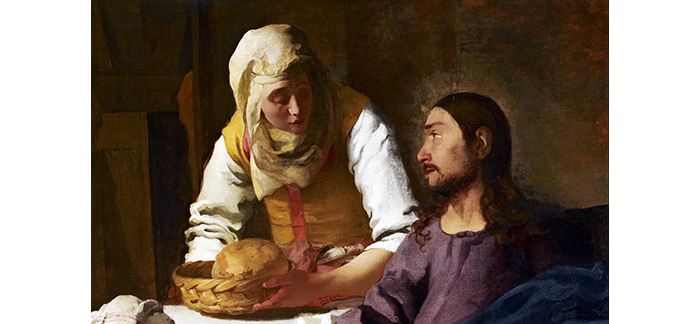Luke 10:38-42
38Now as they went on their way, [Jesus] entered a certain village, where a woman named Martha welcomed him into her home. 39She had a sister named Mary, who sat at the Lord’s feet and listened to what he was saying. 40But Martha was distracted by her many tasks; so she came to him and asked, “Lord, do you not care that my sister has left me to do all the work by myself? Tell her then to help me.” 41But the Lord answered her, “Martha, Martha, you are worried and distracted by many things; 42there is need of only one thing. Mary has chosen the better part, which will not be taken away from her.”
John 11:1-6, 20-27; 12:1-3
11:1Now a certain man was ill, Lazarus of Bethany, the village of Mary and her sister Martha. 2Mary was the one who anointed the Lord with perfume and wiped his feet with her hair; her brother Lazarus was ill. 3So the sisters sent a message to Jesus, “Lord, he whom you love is ill.” 4But when Jesus heard it, he said, “This illness does not lead to death; rather it is for God’s glory, so that the Son of God may be glorified through it.” 5Accordingly, though Jesus loved Martha and her sister and Lazarus, 6after having heard that Lazarus was ill, he stayed two days longer in the place where he was. . . . 20When Martha heard that Jesus was coming, she went and met him, while Mary stayed at home. 21Martha said to Jesus, “Lord, if you had been here, my brother would not have died. 22But even now I know that God will give you whatever you ask of him.” 23Jesus said to her, “Your brother will rise again.” 24Martha said to him, “I know that he will rise again in the resurrection on the last day.” 25Jesus said to her, “I am the resurrection and the life. Those who believe in me, even though they die, will live, 26and everyone who lives and believes in me will never die. Do you believe this?” 27She said to him, “Yes, Lord, I believe that you are the Messiah, the Son of God, the one coming into the world.”
12:1Six days before the Passover Jesus came to Bethany, the home of Lazarus, whom he had raised from the dead. 2There they gave a dinner for him. Martha served, and Lazarus was one of those at the table with him. 3Mary took a pound of costly perfume made of pure nard, anointed Jesus’ feet, and wiped them with her hair. The house was filled with the fragrance of the perfume.
Martha was a dear friend of Jesus, who frequently visited the home in Bethany that she shared with her siblings, Mary and Lazarus. There Jesus found a restful haven, a place where he could be refreshed from his busy days of teaching and ministering to the crowds that so avidly followed him.
Martha received Jesus with open arms and then got on with the work of hosting him. Hospitality is highly regarded in Middle Eastern culture, so it’s natural that she wanted to serve Jesus well. Martha loved Jesus deeply and expressed this love concretely by preparing him a fine meal.
The way Martha welcomed and cared for Jesus shows her recognition of his humanity. Her warmth and hospitality met Jesus’ human needs for nourishment, refreshment, and rest. Moreover, Martha’s welcome meant not just preparing food and lodging for Jesus and his crowd of apostles. It expressed her acceptance of Jesus’ mission and her desire to contribute to it. However, Martha lost sight of the Lord as she bustled about busily. She was a hospitable but harried hostess, so occupied with serving her guest that she couldn’t take the time to sit down with him. When Martha indignantly asked, “Lord, do you not care that my sister has left me to do all the work by myself?” (Luke 10:40), she showed a self-concern that robbed her of the ability to appreciate the precious gift of the moment – fellowship with Jesus.
Jesus pointed Martha in the right direction, helping her to unify her life and prioritize her concerns.
In her complaint, we find the same Greek verb, melei, that the disciples used in their accusation of Jesus during the storm at sea: “Do you not care that we are perishing?” (Mark 4:38). Jesus responded the same way to both upheavals: he calmed the troubled hearts and storms that swept around him. Jesus gently reproached Martha: ”You are worried and distracted by many things” (Luke 10:41). Other English translations of the original Greek text call her “troubled,” “anxious,” “fretting and fussing,” “upset over all these details,” and “bothered about providing so many things.”
Did Martha resent having to serve alone because she felt that Mary was being lazy? Perhaps she was comparing herself to Mary or was a bit jealous of her sister comfortably sitting at their guest’s feet. But no matter what Martha’s anxieties and worries were, she had a profound love for Jesus; she was at ease with him, comfortable and secure in his love and in her friendship with him. She knew where to go when she was upset and needed help – to Jesus– and he pointed her in the right direction, helping her to unify her life and prioritize her concerns.
Jesus’ response to Martha wasn’t a harsh reproof. He knew that her solicitude was genuine, that she was translating her love for him into hospitable acts. Jesus appreciated Martha’s loving labors and recognized the generosity of her bustling nature, but he urged her to relax and enjoy his company. His reply was meant to help Martha recognize how senseless and unnecessary her anxieties were. “There is need of only one thing” (Luke 10:42). Or, as the Living Bible translation reads, “There is really only one thing worth being concerned about.”
We may feel sorry for Martha, left to fix the dinner alone, and begrudge Mary her “better part” at the feet of Jesus. But rather than seeing the postures of the two sisters as mutually exclusive– the active life of service versus the contemplative life of prayer – we should recognize in Martha and Mary complementary aspects of the call given to all followers of Christ. As Scripture commentator Stephen Binz has noted,
In affirming the choice of Mary, we may feel that Martha’s hospitality and service are devalued. Yet, when Jesus highlighted the one thing necessary, he did not mean that everything else has no importance. These sisters are not caricatures of two opposing choices, one of which must be selected over the other. This is not a contrast between a fussy, argumentative busybody and her tranquil, attentive sister. Rather, the sisters express two interdependent aspects of discipleship, both of which are necessary. Hearing the Word and doing it are both essential and complementary facets of following Jesus. There is a time to listen and a time to act.
(Women of the Gospels: Friends and Disciples of Jesus)
Indeed, in each of our lives, there’s a time to listen, to pray, and to sit at Jesus’ feet, and there’s a time to act, to serve, and to wash the feet of those whom the Lord gives us. By balancing action and contemplation in a creative tension in our own lives, we make concrete our love for Jesus. “Be both Martha and Mary. Diligently carry out your duties, and often recollect yourself and put yourself in spirit at the feet of our Lord,” St. Francis de Sales wrote in a letter to a to a married woman seeking spiritual guidance. “Say, ‘My Lord, whether I’m rushing around or staying still, I am all yours and you are all mine. You are my first spouse, and whatever I do is for love of you’” (Letters to Persons in the World).
John the Evangelist gives us a later view of Martha, again free and bold in her friendship with Jesus, as she lamented to him: “Lord, if you had been here, my brother would not have died. But even now I know that God will give you whatever you ask of him” (John 11:21-22). Assured by Jesus that Lazarus – and anyone who believes in him – will rise again, Martha made an amazing declaration of faith in him: “Yes, Lord, I believe that you are the Messiah, the Son of God, the one coming into the world” (11:23-27).
John’s Gospel (12:1-3) also gives us the final scene in which we again see Martha and Mary in their familiar places:
Six days before the Passover Jesus came to Bethany, the home of Lazarus, whom he had raised from the dead. There they gave a dinner for him. Martha served, and Lazarus was one of those at the table with him. Mary took a pound of costly perfume made of pure nard, anointed Jesus’ feet, and wiped them with her hair. The house was filled with the fragrance of the perfume.
Once again Martha is serving and Mary is at the Lord’s feet. Might we think that Martha had learned her lesson well earlier and is now joyful, content, and wholehearted in her loving service, enjoying the fragrance of her sister’s act? Does not each sister delight in honoring their beloved friend in her own way?
Understand!
1. Consider the way in which each of the two sisters welcomed Jesus into their home. What similarities would you note in Martha’s and Mary’s responses to Jesus when he visited them? What differences?
2. What does the account in Luke 10:38-42 suggest to you about Martha’s character and personality? What do the scenes from John 11:1-45 and John 12: 1-3 add to your view of her? Which of Martha’s character traits do you most admire? Why?
3. What, in your opinion, was Martha’s chief motivation in serving Jesus? The main reason for the complaint Martha made to Jesus (Luke 10:40)?
4. What does Jesus’ reply to Martha’s complaint in Luke 10:41-42 reveal about himself? About his outlook toward others and his concern for them? In what tone of voice do you think Jesus replied to Martha? Does Jesus’ reply indicate what is at the heart of Martha’s fretting and her vexation with Mary? Explain your answer.
5. Martha was free to be very open and honest with Jesus, not hiding her feelings. In your own words, describe Martha’s relationship with Jesus. Do you think Martha should have complained directly to her sister rather than to Jesus? Why or why not? Do you think Martha was too forthright and brash with Jesus when she reproached him at Lazarus’ tomb (John 11:21)? Why or why not?
In the Spotlight
Bethany
The home of Jesus’ beloved friends Martha, Mary, and their brother Lazarus was in Bethany (John 11:1), a village located on the eastern slope on the Mount of Olives about three kilometers from Jerusalem on the road to Jericho.
During the last days of his life when Jesus taught daily in the Temple, he was unable to spend the night in Jerusalem because of the plots of the Pharisees. So he withdrew to Bethany (Matthew 21:17; Mark 11:11, 18-19; Luke 19:47-48) – most probably to the house of his dear friends. It was here that Martha served Jesus while Mary sat at his feet, listening to his words (Luke 10:38-42). Their home was a haven where he found rest and refreshment in its loving atmosphere, a place of friendship and hospitality. Here too in Bethany, Jesus raised Lazarus from the dead (John 11:1-44), and soon afterwards a feast was celebrated in Lazarus’ home at which his sister Mary anointed the feet of Jesus with costly ointment (12:1-8). The Gospel of Luke identifies Bethany as the site of Jesus’ ascension into heaven (24:50).
Most likely the village was originally inhabited by the tribe of Benjamin after their return to Palestine from exile in Babylon. The Hebrew word for “house” is “beth,” and the name Bethany may stand for “the house of Ananiah” – the name of one of the Benjamites (cf. Nehemiah 11:32). However, some scholars think Bethany may derive from “Beth-hine,” or “the house of dates.”
During the Byzantine Empire, Bethany was given the name “El-Azariya” – a corruption of the Greek name “Lazareion.” Eusebius of Caesarea, a Greek Church historian, reported that in the fourth century, there was a tomb in the village reputed to be that of Lazarus. A Christian settlement developed there, and archaeologists have established that the area was used as a cemetery in the first century AD, with tombs of this period found a short distance from the church. But while the Catholic Encyclopedia notes that the identification of any particular cave as the actual tomb of Lazarus is “merely possible; it has no strong intrinsic or extrinsic authority,” there is “every reason to believe that it was in this general location.”
Over the following centuries, several Christian churches were successively built near what early tradition held to be Lazarus’ burial cave. In the sixteenth century, Moslems built a mosque at the site of the tomb and barred Christians from gaining access to it. But in 1613 the custos of the Holy Land obtained permission to build a second entrance to the tomb.
The Roman Catholic Church of St. Lazarus was built in 1952–54 over the ruins of former Byzantine and Crusader-era churches, some remnants of which still survive within this newest building. Beside the church is the reputed tomb of Lazarus, a small chamber built of large hewn stones and originally closed by another stone. A flight of uneven rock-cut steps lead down from the street level to the chamber, and pilgrims today can enter it through the entrance built by the Christians in the seventeenth century, a gate only four feet high and two feet four inches wide. The earlier entrance passage constructed by the Moslems was walled up centuries ago.
The Arab population of the area still calls the village of Bethany “El-Azariya,” and the site traditionally known as Lazarus’ tomb is venerated by Christians and Moslems alike.
Grow!
- Imagine how you would go about welcoming Jesus into your home as a guest. What would be your main concern? What would you do to prepare for his visit? Clean house? Cook a meal? Put on a nice outfit? Try to slow down and quiet your spirit?
- Read these Scripture passages about hospitality: Genesis 18:1-8; Romans 12:13; 1 Timothy 5:10; Hebrews 13:2; 1 Peter 4:9. How do you practice hospitality and use your gifts and home to serve others? Have you ever thrown a party and been so preoccupied with replenishing the hors d’oeuvres table and keeping the punch bowl filled that you ignored your guests and missed out on enjoying their company?
- In what areas of your life are you distracted or preoccupied? Why? Is there anything that you are currently worried about? What might you do to find peace and freedom from your anxiety?
- What “complaints” about your life would you bring to Jesus right now? Be honest with Jesus – and with yourself! How do you think Jesus would respond to you? What help would you like him to offer you?
- Ask the Holy Spirit to help you take a good look at your own priorities and schedule. Do you put the Lord first, or do you relegate him to “second place”? How might you make more time and space for Jesus in your life? Should you cut out any “good” but needless activities (or attitudes!) that tend to make you overly busy or anxious like Martha?
This article is adapted from Biblical Women in Crisis: Portraits of Faith and Trust, by Jeanne Kun, © 2017 The Word Among Us, Used with permission.
Top image credit: Martha offers hospitality to Jesus, painting by Jan Vermeer, 1654-56, cropped.
Jeanne Kun is a noted author, and a member of Bethany Association, an international, ecumenical association of women living single for the Lord in various communities of The Sword of the Spirit, and a senior woman leader in the Word of Life Community, Ann Arbor, Michigan, USA.



